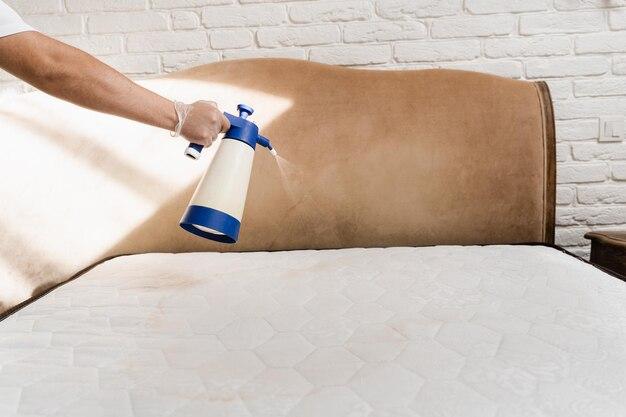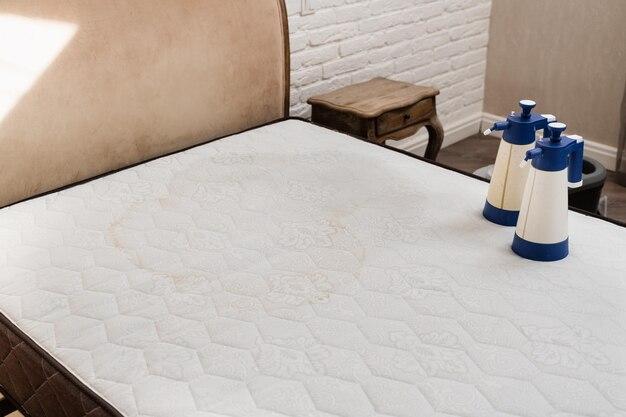Are you wondering how to properly sanitize a used mattress and eliminate any lingering germs? Whether you’ve purchased a second-hand mattress or want to refresh and disinfect your own, it’s crucial to maintain a clean and hygienic sleep environment. In this comprehensive guide, we’ll explore effective methods to sanitize your mattress, using simple ingredients you may already have at home.
From disinfectant sprays to natural remedies, we’ll answer common questions such as: “Can I use alcohol or hydrogen peroxide to disinfect my mattress?”, “Does vinegar remove odors from a mattress?”, and “Should I spray my mattress with alcohol?”. Additionally, we’ll address whether popular products like Lysol and Microban can be safely utilized on bedding and mattresses. So let’s dive in and discover how to ensure your used mattress is fresh, clean, and free from germs for a restful night’s sleep!
\
\
\
How to Sanitize a Used Mattress: Sleep Clean and Germ-Free
So, you’ve managed to score a great deal on a used mattress. Congratulations! Now, before you jump onto that cozy dream cloud, there’s one important step you should never skip – sanitizing. Rest assured, my friend, I’m here to guide you through the process of turning that pre-loved mattress into a clean and germ-free haven. Let’s dive right in!
Gather Your Cleaning Arsenal
Before you embark on this anti-germ crusade, arm yourself with the right tools. You’ll need:
- Vacuum Cleaner: Start by sucking up all the loose debris and dust lurking on the surface.
- Baking Soda: This magical powder is our secret weapon against odors.
- Hydrogen Peroxide: Say hello to a powerful disinfectant that will bid adieu to bacteria.
- White Vinegar: Known for its ability to kill germs and neutralize odors, vinegar is a must-have.
- Spray Bottle: Where else will we mix our cleaning concoction?
Step 1: Strip It Down
Strip the mattress of all its covers, bedding, and protectors. Give them a good wash with hot water and detergent. And yes, don’t forget that mountain of pillows you piled on your bed like you’re building a fortress!
Step 2: Time to Suck It Up
Take your vacuum cleaner and let it roam free on the surface of the mattress. Pay special attention to seams, crevices, and tufted areas where dust mites love to cozy up.
Step 3: Say Goodbye to Stains
Stains on a used mattress? Oh, the stories it could tell! But we’re here to erase those tales. Make a paste of hydrogen peroxide, baking soda, and a dash of dish soap. Apply it to the stains, let it work its magic for about 15-20 minutes, then blot away the remnants with a clean cloth.
Step 4: Deodorize Like a Pro
Now comes the fun part. Sprinkle a generous layer of baking soda all over the mattress. Let it sit for at least a couple of hours, or if you’re feeling extra patient, leave it overnight. Baking soda will absorb those funky odors like a sponge absorbs water. Once the waiting time is up, vacuum it all away.
Step 5: Disinfect and Shine
Mix equal parts of water and white vinegar in a spray bottle. Give your mattress a good spritzing, focusing on areas that need extra love. Vinegar will naturally kill bacteria and germs while bidding adieu to any lingering smells. Let it air dry completely before moving on.
Final Sleep-Ready Touches
Congratulations, you’ve reached the finish line! But before you embrace that squeaky-clean mattress, there are a few additional steps for ultimate peace of mind:
- Use a mattress protector to shield your newly sanitized mattress from future mishaps.
- Flip or rotate your mattress every few months for even wear and tear.
- Don’t forget to sanitize any bed frames or headboards that have been in close contact with your used mattress.
So, there you have it, folks – a step-by-step guide to sanitizing a used mattress. Now you can snuggle up with confidence, knowing that you’ve banished the germs, odors, and any imaginary mattress monsters. Sleep well, dream big, and wake up to a brighter, cleaner world!
You can thank me later! 😉
How to Sanitize a Used Mattress: FAQ Style
What Can I Spray on My Mattress to Kill Germs
To effectively kill germs on your mattress, you can create a DIY disinfectant spray by combining equal parts rubbing alcohol and water in a spray bottle. This simple solution is highly effective in sanitizing and eliminating the potential health risks associated with a used mattress.
What Happens When You Pour Baking Soda into Your Bed
Baking soda is a versatile and affordable cleaning agent that works wonders in absorbing unpleasant odors and moisture. When poured onto your mattress, it helps to neutralize any lingering smells while also acting as a natural deodorizer. Simply sprinkle a generous amount, let it sit for about 30 minutes, and then vacuum it up for a fresher sleep surface.
Can I Spray Alcohol on My Bed to Disinfect
Yes, you can spray alcohol on your bed to disinfect it. Alcohol, specifically rubbing alcohol with a minimum of 70% concentration, is an effective germ-killing agent. However, it’s important to remember that alcohol can be drying, so be mindful of the material and finish of your mattress. Consider spot testing before applying it to the entire surface.
Can You Spray Hydrogen Peroxide on Mattress
Hydrogen peroxide is an excellent disinfectant, but it may not be suitable for all mattress types. While it can effectively kill bacteria and remove stains, it has a mild bleaching effect that may discolor or damage certain fabrics and materials. Before using hydrogen peroxide on your mattress, check the manufacturer’s recommendations or consult a professional.
Can I Use Microban on Bedding
Microban is a powerful antimicrobial agent that can be used on various surfaces, including bedding. It helps to prevent the growth of bacteria, mold, and mildew, providing an extra layer of protection for your sleep environment. However, be sure to follow the manufacturer’s instructions and use it accordingly to ensure safe and effective use.
Is It Safe to Spray Pillows with Lysol
While Lysol is a well-known disinfectant, it’s not recommended to directly spray it on pillows. Pillows often come in close contact with your face, and Lysol contains chemicals that may cause irritation or allergic reactions. Instead, consider using a pillow protector and regularly washing your pillows in hot water to keep them clean and fresh.
Is It Safe to Use Bleach on a Mattress
Bleach is a potent disinfectant, but it’s generally not recommended for use on mattresses. The harsh chemicals in bleach can damage the fibers and materials, potentially leading to discoloration and deterioration. Additionally, the strong smell may linger even after thorough rinsing. It’s best to explore safer alternatives for sanitizing your mattress.
Does Vinegar Remove Smell from Mattress
Yes, vinegar is a natural deodorizer and can help remove unpleasant smells from your mattress. Create a mixture of equal parts white vinegar and water, and lightly spray it on your mattress. Let the solution air dry completely before using your mattress again. The vinegar odor will dissipate as it dries, leaving your mattress smelling fresh.
Why Should You Spray Your Mattress with Alcohol
Spraying your mattress with alcohol, specifically rubbing alcohol, is an effective way to kill germs and sanitize the surface. Alcohol quickly evaporates, leaving behind a clean and dry mattress. It’s particularly useful for eliminating odors and disinfecting after accidental spills, ensuring a more hygienic sleep environment.
How Do Hotels Sanitize Mattresses
Hotels have strict cleaning protocols to ensure that their mattresses are thoroughly sanitized. They often employ professional cleaning services that use specialized equipment such as steam cleaners to sanitize and remove any bacteria, allergens, or stains. Additionally, they frequently rotate and replace mattresses to maintain a high level of cleanliness and comfort.
Can You Use Clorox Wipes on a Mattress
While Clorox wipes are convenient for quick cleaning, they are generally not recommended for use on mattresses. Clorox wipes contain chemicals that may be too harsh for the fabric and materials commonly found in mattresses. It’s best to follow the manufacturer’s guidelines and use safer alternatives to keep your mattress clean and germ-free.
Can You Use Microban on Bed Sheets
Microban can safely be used on various surfaces, including bed sheets. It helps to inhibit the growth of bacteria and other microorganisms, providing an extra layer of protection between washes. Follow the manufacturer’s instructions for proper usage and enjoy the added peace of mind that Microban can bring to your bedding.
How Do I Get Rid of Bacteria in My Bed
To effectively get rid of bacteria in your bed, make sure to regularly wash your bedding, including sheets, pillowcases, and mattress protectors, in hot water. Additionally, consider using a mattress protector to create a barrier against bacteria and other allergens. Routine vacuuming, airing out your mattress, and spot cleaning any stains can further contribute to a cleaner and healthier sleep environment.
Can I Spray Microban on My Mattress
Microban can be safely sprayed on your mattress to provide antimicrobial protection. Before using Microban, read and follow the product instructions carefully. Ensure proper ventilation during and after application, and allow adequate drying time to enjoy the benefits of a refreshed and sanitized mattress.
What Should I Spray My Mattress with Alcohol
To effectively sanitize your mattress with alcohol, create a simple DIY disinfectant spray by mixing equal parts rubbing alcohol and water. Pour the mixture into a spray bottle, and lightly mist your mattress. Be sure to let it air dry completely before putting on any bedding. Feel free to add a few drops of your favorite essential oil to leave a pleasant scent behind.
Can I Spray Lysol on Bedding
Lysol is not recommended for direct application on bedding, as it contains chemicals that may cause skin irritation or allergic reactions. However, you can still keep your bedding clean and fresh by washing it regularly in accordance with the manufacturer’s instructions. Maintaining good hygiene practices, such as washing pillowcases and sheets frequently, is key to a healthy sleep environment.
Do You Have to Wipe off Microban
No, you generally do not need to wipe off Microban. Microban is designed to provide long-lasting antimicrobial protection, so it is typically left to dry naturally on the surface where it was applied. However, it’s important to read and follow the product instructions for specific guidance on application and drying time.
Can Lysol Be Used on Fabric
Lysol can be used on fabric in certain instances, but it’s always best to check the manufacturer’s recommendations first. Some fabrics may be more delicate or react differently to disinfectants like Lysol. If you’re uncertain, spot testing on a small, inconspicuous area of the fabric is a good practice to ensure it won’t cause any damage or discoloration.
How Do You Disinfect a Mattress
To effectively disinfect a mattress, you can follow these steps:
- Vacuum the mattress to remove any dust, dirt, or debris.
- Create a DIY disinfectant spray by mixing equal parts rubbing alcohol and water in a spray bottle.
- Lightly mist the entire surface of the mattress with the solution, ensuring complete coverage.
- Allow the mattress to air dry completely before putting on any bedding.
- Consider using baking soda after the disinfection process to absorb moisture and neutralize odors.
- Vacuum the mattress again to remove the baking soda residue.
- Repeat this process regularly to maintain a clean and sanitized sleep surface.
Is It Safe to Spray Lysol on a Mattress
While Lysol can be effective at killing germs, it’s not recommended to directly spray it on a mattress. Lysol contains chemicals that may not be suitable for all mattress materials. Instead, opt for safer alternatives such as DIY disinfectant sprays using rubbing alcohol and water. Always check the manufacturer’s recommendations and test on small areas first.

